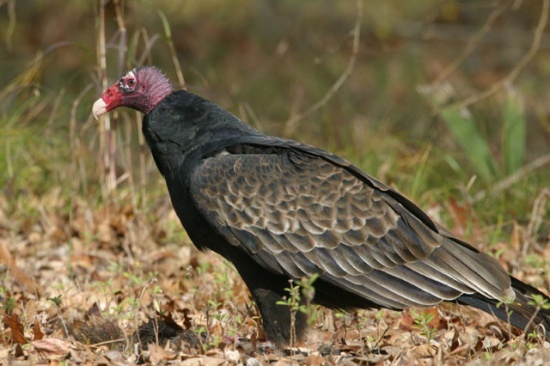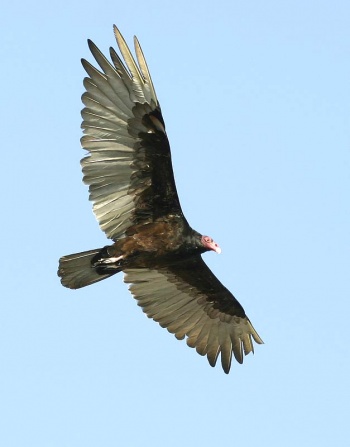m (→Similar Species: - extent of bare skin vs Black - useful for juveniles) |
|||
| Line 12: | Line 12: | ||
[[Image:Turkey_Vulture_flight_by_Nick_Richter.jpg|thumb|350px|right|Photo by {{user|Nick_Richter|Nick Richter}} <br />Irvine, [[California]], June 2004]] | [[Image:Turkey_Vulture_flight_by_Nick_Richter.jpg|thumb|350px|right|Photo by {{user|Nick_Richter|Nick Richter}} <br />Irvine, [[California]], June 2004]] | ||
*head: grayish in Black Vulture and red in adult Turkey. | *head: grayish in Black Vulture and red in adult Turkey. | ||
| − | ** juvenile Turkey Vulture has dark head similar to Black Vulture, but feathers | + | ** juvenile Turkey Vulture has dark head similar to Black Vulture, but feathers almost reach chin. Black vulture has bare throat. |
*underwing: Turkey has silvery secondaries and primaries when seen from below, contrasting with the dark underwing coverts; Black Vulture has white primaries contrasting to both coverts and secondaries as seen from both above and below. | *underwing: Turkey has silvery secondaries and primaries when seen from below, contrasting with the dark underwing coverts; Black Vulture has white primaries contrasting to both coverts and secondaries as seen from both above and below. | ||
*tail: longer in Turkey (make wings appear narrower). | *tail: longer in Turkey (make wings appear narrower). | ||
Revision as of 16:29, 25 January 2016
- Cathartes aura
Identification
- Large and brown to blackish
- Primaries spread during flight (resembling fingers)
- Flight feathers appear silvery below
- Rocking flight with wings held in dihedral (v-shaped)
- Naked pink head (color differ among subspecies)
Similar Species
May be confused with Black Vulture. Separating features:
- head: grayish in Black Vulture and red in adult Turkey.
- juvenile Turkey Vulture has dark head similar to Black Vulture, but feathers almost reach chin. Black vulture has bare throat.
- underwing: Turkey has silvery secondaries and primaries when seen from below, contrasting with the dark underwing coverts; Black Vulture has white primaries contrasting to both coverts and secondaries as seen from both above and below.
- tail: longer in Turkey (make wings appear narrower).
- flight: Black Vulture holds wings nearly flat
Distribution
North, Central and South America.
Breeds in the south of Canada from southern British Columbia to southern Ontario, almost throughout the United States except the far northeast, in Mexico, Central America, part of the Bahamas and the Greater Antilles east to Puerto Rico, and in South America from Colombia and Venezuela south to Tierra del Fuego and the Falkland Islands but rare or absent from much of eastern Argentina. Scarce in the far north but increasing and expanding range. A summer visitor to much of North American range but resident further south.
Northern birds winter in the southern United States from central California to Florida and southwards. Southernmost birds include some migratory populations.
Taxonomy
Subspecies
Four subspecies recognised[1]:
- C.a. aura: from Canada to Costa Rica and Cuba
- C.a. septentrionalis: in eastern North America
- C.a. ruficollis: in Trinidad and from Panama to northern Argentina
- C.a. jota: from Colombia to Patagonia and the Falkland Islands
Some sources mention at least two more subspecies[2]. There is also a suspicion that this species should be studied further because more than one species might be involved.
Habitat
A wide range of habitats from deserts, plains and mountains to forest and jungle. Cruises over all terrestrial and shoreline habitat
Behaviour
Diet
Often scavenges at refuse-tips and along roadsides and shorelines.
Vocalisation
Hisses and grunts given at the nest
References
- Clements, J. F., T. S. Schulenberg, M. J. Iliff, D. Roberson, T. A. Fredericks, B. L. Sullivan, and C. L. Wood. 2015. The eBird/Clements checklist of birds of the world: v2015, with updates to August 2015. Downloaded from http://www.birds.cornell.edu/clementschecklist/download/
- Alvaro Jaramillo. 2003. Birds of Chile. Princeton Field Guides. ISBN 0-691-11740-3
Recommended Citation
- BirdForum Opus contributors. (2025) Turkey Vulture. In: BirdForum, the forum for wild birds and birding. Retrieved 5 February 2025 from https://www.birdforum.net/opus/Turkey_Vulture
External Links





